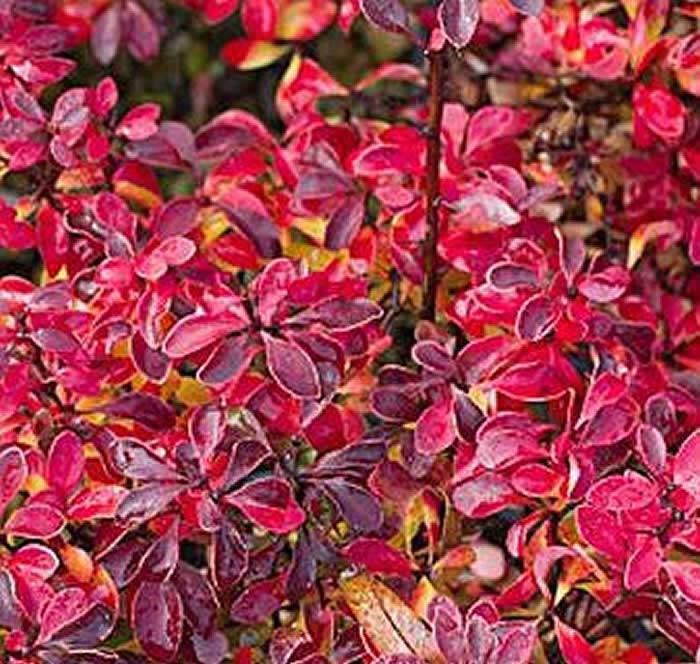Berberis Thunbergii Japanese Barberry are low maintenance shrubs with high decorative value & stunning autumn colour. Because of their prickly barbs, they make ideal defensive hedging, keeping out unwanted visitors. Berberis Thunbergii is a good choice for outstanding autumn colour, keeping its foliage longer than other varieties of Berberis & with berries lingering on through winter.
Berberis is a tough, hardy shrub. The thunbergii variety of Berberis (Berberis thunbergii Japanese Barberry) are sometimes called the red barberry family. An effective shrub, Berberis Thunbergii won’t be eaten or damaged by deer. It is thorny but if you have a greenbelt area or a large mixed border, you can simply let it grow to do its own thing. Left to its own devices, Berberis Thunbergii Japanese Barberry has a naturally compact growth habit that can look very good in mixed borders. It is also suitable for hedging – keep it clipped to form a dense, low-growing hedge with year round interest from the changing colours of the foliage, the flowers in late spring to the berries in the autumn / winter. Size wise, Berberis Thunbergii won’t get much higher than circa 1 to 1.5 metres so it’s very much a medium sized shrub.
While there are many Berberis varieties, we tend to focus on those with the most striking autumn colour and those with attractive, long lasting berries. The thunbergii cultivars in particular keep their colour longer than other varieties and once the foliage does finally fall, the berries linger on dramatically throughout the winter. Of particular note are Berberis Thunbergii Admiration and Berberis Thunbergii Orange Rocket.
Berberis Thunbergii Atropurpurea – the red leaf Japanese barberry – has striking red / purple foliage. The atropurpurea varieties can be used to create contrast between the green ground cover and the nice red purple foliage of these shrubs. The red leaf Japanese barberry can be used to great effect in garden design due to its distinctive wine red foliage. It is very attractive when grown in clumps. Although a deciduous plant, Berberis Thunbergii Atropurpurea are well worth growing for the amazing colour. The Atropurpurea varieties prefer full sun if possible to get the most of red foliage. They will tolerate most soil types, provided they are not water logged.
Berberis Thunbergii Pow Wow has a compact upright shape and won’t get overly large yet still having high ornamental value.

Berberis Thunbergii Atropurpurea – the red leaf Japanese barberry – has striking red / purple foliage.
The purple leave varieties of Berberis Thunbergii Atropurpurea have many cultivars. We would recommend Berberis Thunbergii F Atropurpurea Harlequin, with a lovely compact growing habit, yellow flowers in spring and beautiful deep red berries in autumn, all offset by the purple red foliage. This plant is a recipient of an RHS award.
Berberis Thunbergii Atropurpurea Concorde or Japanese Barberry Concorde is a low growing variety of Berberis with an attractive dome shape and dark red-purple foliage.
A slightly larger variety of Berberis Thunbergii Atropurpurea and equally stunning is the Red Chief variety. Its lovely purple foliage turns a vibrant red in autumn. It will reach a maximum height and spread of 1.5 metres.
If purple red foliage is what you are after, another Berberis genus worth a mention is Berberis x Ottawensis Purpurea ‘superba’, a vigorous growing hybrid of Berberis Thunbergii and Berberis Vulgaris (European Barberry). This is a larger shrub than the Berberis Thunbergii Atropurpurea varieties and can reach circa 3 metres tall. It has attractive reddish brown stems and its foliage, for which it is prized, is a lovely purple red with hues of green. It bears fruit in autumn when it is covered in attractive red berries. Berberis x Ottawensis Purpurea ‘superba’ has received the RHS Award of Garden Merit.






